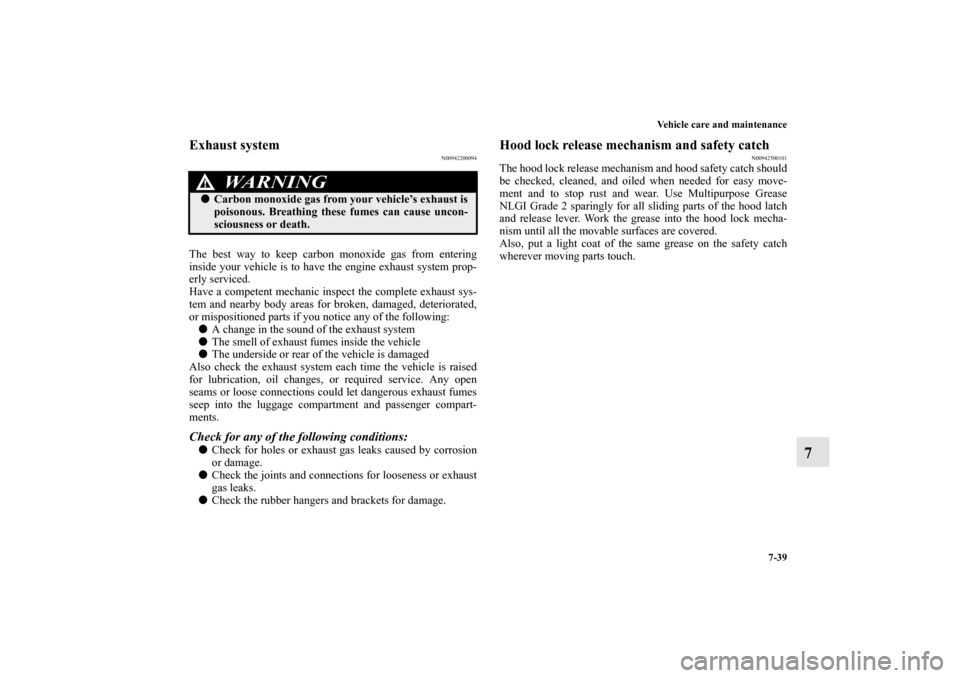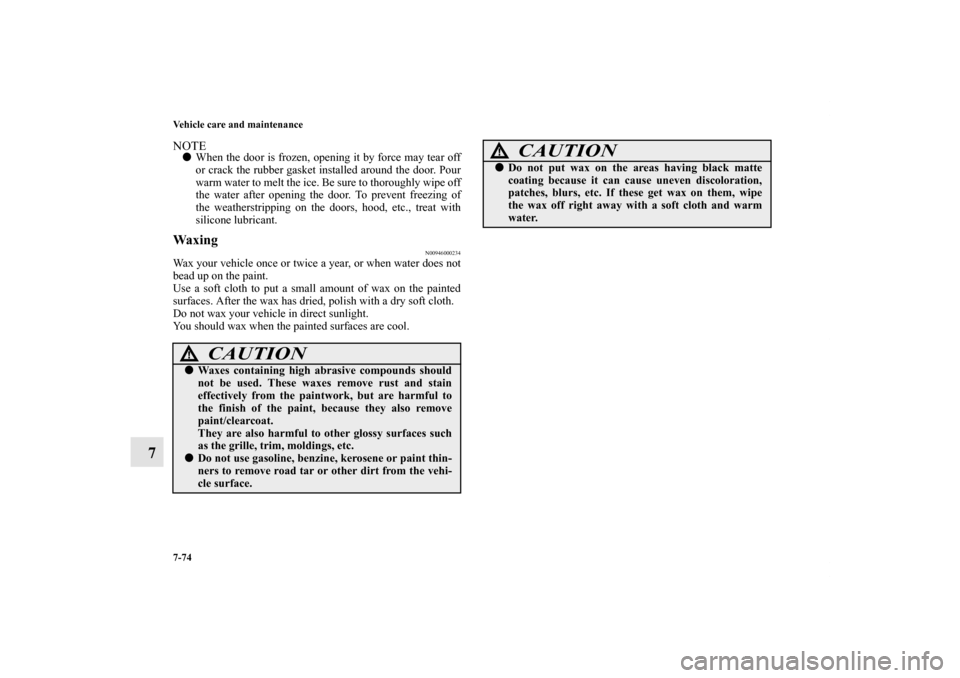Page 517 of 602

7-16 Vehicle care and maintenance
7Wa s h e r f l u i d
N00938600299
The windshield and rear window washer fluid reservoir is in
the engine compartment.
Check the washer fluid level at regular intervals and add
washer fluid to reservoir if necessary.
Open the reservoir cap and check the fluid level with the dip-
stick.
When freezing weather is anticipated, flush out the water in the
reservoir by operating the pump. Fill the reservoir with wind-
shield antifreeze (not radiator antifreeze), and operate the sys-
tem for a few seconds to flush out the residual water.
Brake fluid/Clutch fluid
(if so equipped)
N00938700245
The brake fluid and the clutch fluid share the reservoir tank.To check the fluid levelThe fluid level must be between the “MAX” and “MIN” marks
on the reservoir.
The fluid level falls slightly with wear of the brake pads, but
this does not indicate any abnormality.
The fluid in the master cylinder should be checked when doing
other work under the engine hood. The brake system should
also be checked for leaks at the same time.
If the fluid level falls markedly in a short length of time, it indi-
cates leaks from the brake system.
If this occurs, have the vehicle checked by an authorized Mit-
subishi Motors dealer or a repair facility of your choice.
FULL
EMPTY
MAX
MIN
BK0120400US.book 16 ページ 2010年5月12日 水曜日 午前10時50分
Page 540 of 602

Vehicle care and maintenance
7-39
7
Exhaust system
N00942200094
The best way to keep carbon monoxide gas from entering
inside your vehicle is to have the engine exhaust system prop-
erly serviced.
Have a competent mechanic inspect the complete exhaust sys-
tem and nearby body areas for broken, damaged, deteriorated,
or mispositioned parts if you notice any of the following:
�A change in the sound of the exhaust system
�The smell of exhaust fumes inside the vehicle
�The underside or rear of the vehicle is damaged
Also check the exhaust system each time the vehicle is raised
for lubrication, oil changes, or required service. Any open
seams or loose connections could let dangerous exhaust fumes
seep into the luggage compartment and passenger compart-
ments.Check for any of the following conditions:�Check for holes or exhaust gas leaks caused by corrosion
or damage.
�Check the joints and connections for looseness or exhaust
gas leaks.
�Check the rubber hangers and brackets for damage.
Hood lock release mechanism and safety catch
N00942500101
The hood lock release mechanism and hood safety catch should
be checked, cleaned, and oiled when needed for easy move-
ment and to stop rust and wear. Use Multipurpose Grease
NLGI Grade 2 sparingly for all sliding parts of the hood latch
and release lever. Work the grease into the hood lock mecha-
nism until all the movable surfaces are covered.
Also, put a light coat of the same grease on the safety catch
wherever moving parts touch.
WA R N I N G
!�Carbon monoxide gas from your vehicle’s exhaust is
poisonous. Breathing these fumes can cause uncon-
sciousness or death.
BK0120400US.book 39 ページ 2010年5月12日 水曜日 午前10時50分
Page 575 of 602

7-74 Vehicle care and maintenance
7
NOTE�When the door is frozen, opening it by force may tear off
or crack the rubber gasket installed around the door. Pour
warm water to melt the ice. Be sure to thoroughly wipe off
the water after opening the door. To prevent freezing of
the weatherstripping on the doors, hood, etc., treat with
silicone lubricant.Waxing
N00946000234
Wax your vehicle once or twice a year, or when water does not
bead up on the paint.
Use a soft cloth to put a small amount of wax on the painted
surfaces. After the wax has dried, polish with a dry soft cloth.
Do not wax your vehicle in direct sunlight.
You should wax when the painted surfaces are cool.
CAUTION
!�Waxes containing high abrasive compounds should
not be used. These waxes remove rust and stain
effectively from the paintwork, but are harmful to
the finish of the paint, because they also remove
paint/clearcoat.
They are also harmful to other glossy surfaces such
as the grille, trim, moldings, etc.�Do not use gasoline, benzine, kerosene or paint thin-
ners to remove road tar or other dirt from the vehi-
cle surface.
�Do not put wax on the areas having black matte
coating because it can cause uneven discoloration,
patches, blurs, etc. If these get wax on them, wipe
the wax off right away with a soft cloth and warm
water.
CAUTION
!
BK0120400US.book 74 ページ 2010年5月12日 水曜日 午前10時50分